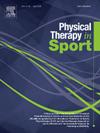针对男性和女性后蹲时髋关节和/或膝关节伸肌:使用躯干和胫骨倾斜和膝关节屈曲角度的相对差异进行重复测量决策树分析
IF 2.2
3区 医学
Q1 REHABILITATION
引用次数: 0
摘要
目的探讨深蹲时,躯干和胫骨的相对倾斜度以及膝关节屈曲对髋关节和膝关节伸肌的影响。DesignRepeated措施。大学研究实验室。参与者为16名健康个体。计算深蹲时髋关节/膝关节伸肌力矩比(HKR)平均值,以及膝关节屈曲高峰时躯干-胫骨倾斜度差和膝关节屈曲角度。重复测量的回归树确定了躯干-胫骨倾斜度差和膝关节屈曲角度的组合预测HKR。结果以躯干-胫骨倾斜度差(主要预测因子)和膝关节屈曲(次要预测因子)预测shkr。出现了四种深蹲策略:膝关节伸肌偏倚(平均HKR = 0.3)、中性偏倚(平均HKR = 0.9)、髋伸肌偏倚(平均HKR = 1.5)和髋伸肌偏倚(平均HKR = 2.2)。当躯干倾斜度超过胫骨倾斜度(≥2.2°)时,明显为髋偏下蹲。深蹲仅影响髋偏深的深蹲:中等深度时髋伸肌偏大(膝屈度为96°),深度较大时髋关节偏小(膝屈度≥96°)。结论我们的研究结果为深蹲训练的意图偏向提供了一个框架。为了最大化或最小化髋关节相对于膝关节伸肌的需求,临床医生应该认识到躯干相对于胫骨的倾斜度和膝关节屈曲的影响。本文章由计算机程序翻译,如有差异,请以英文原文为准。
Targeting the hip and/or knee extensors during the back squat in males and females: A repeated measures decision tree analysis using the relative difference in trunk and tibia inclination and knee flexion angle
Objective
To determine what combination of relative trunk and tibia inclination and knee flexion biases the hip and knee extensors during the squat.
Design
Repeated measures.
Setting
University research laboratory.
Participants
16 healthy individuals.
Main Outcome Measures
The average hip/knee extensor moment ratio (HKR) was calculated during squat descent, and trunk-tibia inclination difference and knee flexion angle at peak knee flexion. A regression tree for repeated measures determined what combination of trunk-tibia inclination difference and knee flexion angle predicted HKR.
Results
HKR was predicted by trunk-tibia inclination difference (primary predictor) and knee flexion (secondary predictor). Four squatting strategies emerged: knee extensor bias (average HKR = 0.3), neutral bias (average HKR = 0.9), hip extensor bias (average HKR = 1.5), and high hip extensor bias (average HKR = 2.2). When trunk inclination exceeded tibia inclination ( ≥ 2.2°), hip-biased squatting was evident. Squat depth affected only hip-biased squatting: high hip extensor bias at moderate depths (<96° knee flexion), and a less pronounced hip bias at greater depths ( ≥ 96° knee flexion).
Conclusions
Our results provide a framework to bias the squat exercise based on intent. To maximize or minimize hip relative to knee extensor demands, clinicians should be cognizant of the trunk inclination relative to tibia inclination and the influence of knee flexion.
求助全文
通过发布文献求助,成功后即可免费获取论文全文。
去求助
来源期刊

Physical Therapy in Sport
医学-康复医学
CiteScore
4.50
自引率
8.30%
发文量
125
审稿时长
39 days
期刊介绍:
Physical Therapy in Sport is an international peer-reviewed journal that provides a forum for the publication of research and clinical practice material relevant to the healthcare professions involved in sports and exercise medicine, and rehabilitation. The journal publishes material that is indispensable for day-to-day practice and continuing professional development. Physical Therapy in Sport covers topics dealing with the diagnosis, treatment, and prevention of injuries, as well as more general areas of sports and exercise medicine and related sports science.
The journal publishes original research, case studies, reviews, masterclasses, papers on clinical approaches, and book reviews, as well as occasional reports from conferences. Papers are double-blind peer-reviewed by our international advisory board and other international experts, and submissions from a broad range of disciplines are actively encouraged.
 求助内容:
求助内容: 应助结果提醒方式:
应助结果提醒方式:


